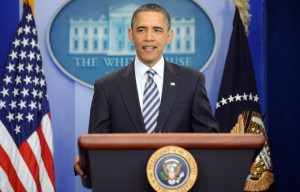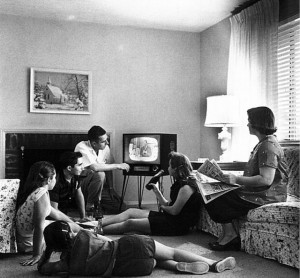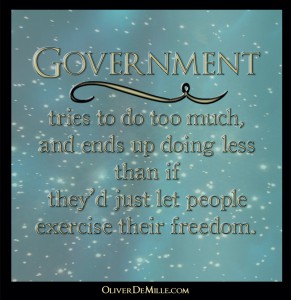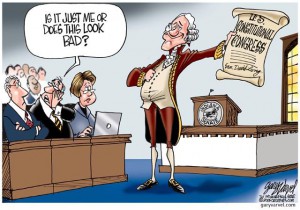Understanding Obama (What is the President Thinking?)
November 23rd, 2015 // 6:02 am @ Oliver DeMille
Confusion and Concerns
 In the last couple of weeks I’ve heard the words “baffling,” “ridiculous,” “out of touch,” “unhinged,” and “I just don’t understand what he could possibly be thinking”—all directed at President Obama’s response to the tragedies in France and Mali. “It’s just like his answer to people shooting police officers,” many people are thinking, “His tone is all wrong. He thinks the good guys are the bad guys, and that the bad guys are the good guys.”
In the last couple of weeks I’ve heard the words “baffling,” “ridiculous,” “out of touch,” “unhinged,” and “I just don’t understand what he could possibly be thinking”—all directed at President Obama’s response to the tragedies in France and Mali. “It’s just like his answer to people shooting police officers,” many people are thinking, “His tone is all wrong. He thinks the good guys are the bad guys, and that the bad guys are the good guys.”
Actually, that’s exactly right. It’s a little more complicated than that, however. It boils down this: for seven years many pundits have been saying that President Obama is a centrist and a pragmatist, a Democratic centrist, yes, but not part of the far Left. But he’s acting like he is part of the far Left, now more than ever.
For example, if President Obama is a member of the far Left, this would easily explain his responses to the French massacre. The far Left tends to see the world as broken into two groups: the Oppressors and the Oppressed. Also, in this view, the Oppressors typically look and act a certain way: they hold positions of institutional power, they dress in expensive clothes, and they tend to talk for a living. Moreover, the Oppressors generally promote more power for themselves and others like them—and less for everyone else.
As president, a person with this view of the world (a place made up of Oppressors vs. Oppressed, always battling each other), is going to struggle when it comes to terrorism. Specifically: where most Americans see terrorists as the bad guys, the far Left sees people on Wall Street, big banks, the Right, K Street, Madison Avenue, and big business as the bad guys.
Likewise, where many Americans tend to see a police shooting (in, say, Ferguson, or Baltimore) as law enforcement officers protecting the Oppressed, the far Left sees it exactly the opposite—the police as tools of middle- and upper-class Oppressors, using their power to hurt the Oppressed under-classes.
The far Left tends to see terrorists as the Oppressed just looking for a way to get out from under the controls and dominating systems put upon them by Oppressive rich nations and their banks, rules, borders, etc. In this view, these things keep the poor poorer, and allow the rich to get richer.
It’s a matter of cultural dissonance. The two sides simply see the world very differently. In fact, many people see some of the elites as the bad guys. But the far Left takes it to an extreme: everyone is either helping the Oppression, often by mere inaction, or actively fighting against it.
The Divide
This isn’t anything new, of course. It’s been around for centuries. Greek, Roman and European history is full of this disconnect. It shows up in Biblical history and in ancient Egypt and Babylon. But what would be new, and different, is a president in the White House who generally sees things from the far Left viewpoint.
Such a president would see terrorism, and he would know it is wrong. He would say so. But he would also see in terrorism a fight of the Oppressed against their Oppressors, and he would view them as people trying to overcome the plight of the Oppressed.
Such a president would be willing to fight against terrorism, even sending troops and drones. But when he saw Republican rhetoric against refugees, or immigrants, would he view people who speak this way as the bad guys or the good guys? Clearly, he would think Republicans are the Oppressors, not the good guys.
Thus he would be able to stand in a press conference and unemotionally talk about the misdeeds of the terrorists in France, and only seem to get really emotional, really upset, when the topic turns to Republicans or reporters who question his motives. The Republicans and media seem like the bad guys, because they seem like Oppressors.
They would appear to be everything the far Left teaches about Oppressors—smug, educated, sure of their own righteousness, wealthy, powerful—while many of the terrorists fall into the category the far Left describes as desperate, misguided people seeking to throw off Oppression.
Where most people see terrorism as pure evil, a president with a far Left view would believe: The terrorists have the right goals (to overcome oppression), but use the wrong methods (terrorism). In contrast, the same president would believe that the Republicans and media have the wrong goals and the wrong methods, even though their methods are less extreme.
And, from the far Left view, the efforts of conservatives, bankers, middle class voters, media pundits and other Oppressors are downright wrong—and they must be stopped. Not violently, but stopped nonetheless. As a result, those on the far Left stop the terrorists because it is their duty, but they gleefully want to stop the middle class and elite “Oppressors” because they represent what in the far Left’s opinion is really, truly wrong with the world.
This view would also show up when a far Left president was speaking about police shootings. He/she would be seldom on the side of the police, often on the side of the non-police. Oppressors vs. Oppressed. Another example would arise when such a president addressed religion: often taking the side of Muslims, seldom siding with Christians. From the far Left viewpoint, this isn’t an issue of religion at all, but rather the ideal of always siding with the Oppressed minority against the Oppressive majority.
I don’t know if this critique is an accurate portrayal of the current president. I don’t know him, so I’m left with what the media shares. But this critique certainly explains a lot of his behaviors, and many of his words. It is indicative of many on the far Left. For example, when asked who her worst enemies were, Hillary Clinton mentioned terrorists as a problem but ended up calling “Republicans” her worst enemies.
She later said it was a joke. But the fact that she and many others laughed at the joke, and found it funny, is telling. People on both sides of the political divide frequently make this mistake, thinking that other Americans are really the great enemy, when so many worse enemies are out there (e.g. terrorists, Iran, Russia, China, North Korea, etc.).
What are the Solutions?
In all this, the real issue for most Americans is one of leadership. We are a nation divided. Divided about who the good guys are, and who the bad guys really are.
A nation where the majority of people don’t assume that the police are the good guys is in deep trouble. Very deep trouble. Yet our current President has seemed to signal this very thing on numerous occasions. This is a big problem.
Perhaps just as big, if not even bigger, is the President’s inability to passionately call out terrorism and unite the nation in defeating it. His attacks on terrorism seem half-hearted. For example, during the first Gulf War the allies sent out an average of nearly 1200 bombing sorties a day. In contrast, during the anti-ISIS attacks over the past 18 months, the Obama group has sent on average 6-8 sorties a day. That’s not a typo. It’s 1200 a day, versus 6-8 day. That’s a huge difference!
In short, those on the far Left aren’t really interested in foreign issues. They are focused on reformatting America, using government to transfer more and more power, money, and influence from the “Oppressive middle and upper classes” to the “Oppressed” under classes. Foreign policy is a distraction for them. They are annoyed when foreign policy problems come up at all, and wish they would just go away. For example, the President truly seems more passionate about taking away guns from law-abiding American citizens than he is about stopping terrorists.
With that kind of fuzzy leadership, not much is going to get done. The next time we elect a president, we need to look for someone whose words are crystal clear about what’s really important. Above all, the main purpose of the national government is national defense. And the main purpose of state and local governments is protection from murder, rape, theft and other violent crimes. Stopping these things is the reason government was invented in the first place.
Perhaps part of the reason political leadership has become so fuzzy is that our elected officials are doing far too much. If they focused on excellent national defense, and true public safety, and ensured freedom for all, we’d be in a much better place. That shouldn’t be too much to ask—a simple focus on protection of life, liberty and the pursuit of happiness.
The good news is that our national problems aren’t insurmountable. But without real leadership, things just struggle and worsen. This doesn’t mean that more bombing is the only answer. There are other options. But one thing is certain: Our nation desperately needs true leadership right now.
Category : Aristocracy &Blog &Citizenship &Community &Culture &Current Events &Foreign Affairs &Generations &Government &History &Leadership &Liberty &Politics
An Update on the U.S. Economy
November 19th, 2015 // 2:28 pm @ Oliver DeMille
All in the Family
 A poll by the Pew Research Center shows that, beginning in 2014, the percentage of young women living at home or with family members is the highest since 1940. The number of young men moving home is also growing rapidly, but hasn’t quite topped the 1940 mark yet.
A poll by the Pew Research Center shows that, beginning in 2014, the percentage of young women living at home or with family members is the highest since 1940. The number of young men moving home is also growing rapidly, but hasn’t quite topped the 1940 mark yet.
A significant factor in this shift is that more and more young college graduates are unable to find jobs. Another contributor is that many of the jobs young people do find don’t pay as much as they did for twenty-somethings over the past several decades.
Beyond the college changes, high rent and higher costs of living for everyone are contributing to this change. In short, more young people are staying or moving back home.
Could this be a cyclical return to the multi-generational family households that dominated the 1930s? If so, we would expect to see more grandparents moving in with middle-age children and their families (or vice versa)—and, in fact, this is also occurring. Some eras of history—those with long economic downturns or very slow economic growth—naturally tend toward multi-generational families.
Still Sputtering
Overall, the U.S. economy is still struggling, even though the Great Recession began seven years ago, and even though Washington claims it ended four years ago. But since 2011, we’ve seen only very small growth in the U.S. economy, around 1-2% annually.
For many people, this level of growth doesn’t keep up with the annual increases in their expenses. Many families still feel like the Great Recession never ended, because they seem to be falling further behind. And while the Obama Administration touts the increased numbers of jobs in the past four years, most of these jobs pay much less, and offer fewer benefits (if any), than those so many people lost between 2008 and 2012.
In other words, the recession may technically be over—on paper—but look at the numbers more closely and the economy is still sputtering. Over ninety thousand Americans have now stopped looking for work, so the lower unemployment numbers don’t really mean that lots of jobs—or good jobs—are back.
They aren’t.
The New Economic Normal?
All in all, the Obama Administration has taken the approach that 1-2 percent annual growth for our economy—with lower-paying jobs and more people relying on increased government benefits to survive—is the new normal. The Hillary Clinton and Bernie Sanders campaigns have voiced the same sentiment.
In fact, the Democratic candidates daily make the case that government should offer many more programs (a national $15 minimum wage, free college, increased welfare funds, etc.) so people can get used to making do, even without jobs. Obamacare already did this for health care, though rising costs are causing numerous problems for those who do pay for their own health care.
In contrast, many of the Republican candidates for the 2016 election have argued that we need to get back to 4% annual growth or much, much higher. Whether any of the candidates can win in 2016, and then actually do something to significantly boost the economy, remains to be seen.
We may well be at a national crossroads. If we follow the Democratic path, we’ll increase taxes and depend more on government to help families make ends meet. And paying the bills will be increasingly difficult.
If we adopt the perspective of some Republicans that we really can reboot the economy and spur 4%, 6%, or even higher growth, we can restart the American Dream for the current and next generation. But can any of the Republican candidates actually do it? Only time will tell. At least some of them are trying.
What Actually Works
Let’s be clear. Governments don’t spur economic booms. Entrepreneurs, small businesses, and big businesses that expand and hire do. But when the government regulatory burden and tax rates are as high as they are right now, it’s going to take some government action to free up the economy and incentivize more entrepreneurs and businesses to take action toward major growth.
As for the trillions of dollars held by U.S.-based corporations abroad, the government needs to bring our tax rates down to the point that it makes sense to bring this money back home to the U.S. economy. So, yes, the free economy needs real relief from government right now.
The next election could make all the difference. We’ll either reinforce the Obama legacy and put more people into low-paying (or no) jobs and onto government benefit rolls, or we’ll reboot the economy by freeing it up and incentivizing free enterprise growth, hiring, and expansion.
These are two very clear, opposite directions, and only one of them even has the chance of benefiting American freedom and prosperity in the years ahead. Our economy is at stake.
Category : Blog &Citizenship &Community &Culture &Current Events &Economics &Education &Family &Generations &Government &History &Leadership &Liberty &Politics
Beware the “Institutionalists”
October 5th, 2015 // 6:44 pm @ Oliver DeMille
by Oliver DeMille
Too Much
 The word “Institutionalist” keeps popping up in the worst places. It appeared when the Supreme Court upheld Obamacare, and the swing vote came from Chief Justice John Roberts. When asked why this Republican appointee would side with justices from the Left, the response was that Roberts is an “Institutionalist”.
The word “Institutionalist” keeps popping up in the worst places. It appeared when the Supreme Court upheld Obamacare, and the swing vote came from Chief Justice John Roberts. When asked why this Republican appointee would side with justices from the Left, the response was that Roberts is an “Institutionalist”.
This means that his primary focus is maintaining or increasing the status and historical legacy of the Court.
Let’s be clear. The central point of Court “Institutionalists” isn’t about providing justice. Nor is it making sure the Constitution is most effectively applied. It’s not even about winning for the principles of freedom.
All of these are important, of course. But the main focus of “Institutionalists” comes down to keeping the institution of the Court as impressive as possible.
Is this really the right top goal for a Chief Justice?
When Speaker of the House John Boehner announced his resignation, he was asked why he didn’t powerfully take on President Obama’s agenda, use every possible tool to reverse Obamacare, or effectively fight against other negative liberal programs. He answered that these things weren’t really possible without too much battling, and that as Speaker he had the responsibility to protect the institution of the House.
Many in the media called him an “Institutionalist,” one whose main goal is trying to maintain and increase the status of the House. Again, his primary focus wasn’t stopping negative agendas from the Obama Administration. Nor was it reversing Obamacare or the terrible Iran deal. It wasn’t about rebooting the economy, nor did it focus on blocking the horrific practices of Planned Parenthood. Rather, instead of all these things, Boehner’s focus was on Institutionalism.
Is this what we actually want from our Speaker of the House?
Senate Majority Leader Mitch McConnell is another “Institutionalist.” His top focus does not appear to be promoting great conservative polices, or even fighting negative agendas from the Obama White House. It seems to be trying to make the Senate as an institution look as good as possible to the media and the general population.
Is this the right focus for the Senate Majority Leader?
Add this all up, and Institutionalism is a very bad agenda. First, note that approval ratings for Congress are incredibly low, below 10%. It’s almost impossible to get more unpopular than Congress is right now. In other words, if the goal is Institutionalism, those promoting it are failing miserably.
The Split
Second, and more importantly, voters don’t send Congressmen and Senators to Washington to become great “Institutionalists.” It’s not a priority—or even an issue at all—for most Americans. In contrast, voters do send their representatives to Congress to do the things they really care about.
The Democrats seem to get this. Harry Reid and Nancy Pelosi certainly weren’t “Institutionalists” when they were in power. They gave their hearts and souls to fighting for the liberal agendas they believe in and campaigned about—using every possible tool and opportunity. In fact, if no opportunity was available, they found a way to make one. And they got most of what they wanted. The same is true of President Obama.
If only conservative leaders would fight for their agendas with half as much purpose and tenacity as such Democrats. When Republicans are in Congressional and Court leadership, they too frequently stop standing strongly for the principles of freedom and fighting for them with all their might, and instead hide behind the idea of Institutionalism.
But, again, when Democrats lead the Congress and Court, they don’t claim Institutionalism. They set their liberal agenda and go after it with all their will and resources.
The result is that when Democrats win elections, they swing the nation widely and effectively in the liberal direction, but when Republicans win elections, they too often weakly hide behind the concept of Institutionalism and don’t fight strongly for conservative ideals. Predictably, even when Republican voters win, they just watch the nation drift more liberal because their own leaders don’t do what they promised.
In short: We get more liberal when Democrats are in national leadership, and we frequently get more liberal when Republicans are in national leadership. If you want to see more values and policies based on true principles of freedom, we better get new leadership.
And this split isn’t limited to Right versus Left. It dominates the internal workings of the Republican Party as well. The GOP Establishment emphasizes maintaining the institutions of government. Yes, it wants Republicans to lead such institutions, but Institutionalism runs rampant in the Establishment. The words “Establishment” and “Institutional” are basically synonymous.
Purpose
In contrast, many Republicans want government to make major changes and really fix our nation. Reverse the $19 trillion debt (by comparison, it was $9 trillion when President Obama took office). End government deficits. Restore our national security to a much higher level. Reboot the American economy.
We want real change. It is desperately needed.
For most Americans, the institutions we want to flourish and thrive are our families, communities, the U.S. economy, and genuine American freedom. We want our elected officials to stop being “Institutionalists” and instead use institutions like the House, Senate, Court and Presidency to do what these institutions were designed for in the first place—actually help the people.
Anyone who has been in the House, Senate, Court, or other government institutions long enough to passionately care a great deal about the legacy and traditions of that institution, has been there too long. It’s time to vote such officials out of office and replace them with someone new, someone who cares a lot more about really fixing America, the economy, and helping the people than about loving the legacy of some institution.
To repeat: A politician who fawns over and lauds his/her government institution like a college alma mater or his church, has been there too long. The institutions aren’t about groupies and aficionados; they exist to help the people. This is especially true of government institutions.
We should shun institutionalism. That’s not what Washington’s institutions are for. And it’s certainly not why we elect our representatives.
Category : Blog &Citizenship &Community &Constitution &Culture &Current Events &Economics &Government &Leadership &Liberty &Politics
How to Realistically End Obamacare and Stop the Iran Deal
September 22nd, 2015 // 11:21 am @ Oliver DeMille
by Oliver DeMille
Emotions and Questions
 A lot of Americans are deeply frustrated. Many of them are downright angry about the direction our nation is taking. We use our power as citizens to change things—through elections. We send Congressmen and Senators to reverse things we don’t like, but they don’t do much. Why? “Because they can’t,” people tell me. “Because the president will just veto whatever they do. Or the Court will just decree whatever it wants. We’ve got no power. Our votes don’t accomplish anything.”
A lot of Americans are deeply frustrated. Many of them are downright angry about the direction our nation is taking. We use our power as citizens to change things—through elections. We send Congressmen and Senators to reverse things we don’t like, but they don’t do much. Why? “Because they can’t,” people tell me. “Because the president will just veto whatever they do. Or the Court will just decree whatever it wants. We’ve got no power. Our votes don’t accomplish anything.”
The Founder’s Way
The American founding fathers knew that situations like this would come up, so they wrote the Constitution in a very specific way. They gave the power of the purse strings to the House of Representatives for two vital reasons:
First, because they knew that the power to fund or defund any government action was the ultimate power in the Constitution. This power affects everything the government does. No budget equals no personnel, no staff, no petty cash, no anything. This is real teeth. And the framers gave it to the House so they would use it!
Second, the framers gave this power only to the House of Representatives. Why? Because Congressmen are elected directly by the voters, and they are elected every two years. Thus if Washington gets off track, the voters can re-constitute the entire House of Representatives every 24 months. The whole thing. And this new House can totally rewrite the budget. All of it .The House can refuse to fund anything, and that thing will go away.
The framers wanted the House to use the purse powers to defund or refuse to renew funding on things the people don’t like—such as Bush’s torture policies or secret big data spying on American citizens, or today’s Obamacare, federal funding of Planned Parenthood, the Iran deal, and other proposals at this level. That’s why the framers set up the Constitution the way they did.
Presidential vetoes, Court decisions, Senatorial refusals to confirm a presidential nomination, and House refusal to funding: these are all routine constitutional tools. And let’s be clear. The power of the purse is the exact level of extreme that the framers made it. The Court can say something’s constitutional and even say this part of government should stay open. The House can decide whether to fund that thing with $3 trillion or with 30 cents.
The framers knew that the president would have the power of the military, the Court would have the power of legal decisions, the Senate the power of treaties—and they wanted the House to have an equal power. This is the people’s power. This is the House’s power. It is pretty much their only real power. If they don’t use it, they have very little power. But if they do use it, they have the most power in Washington.
Indeed, the power of the purse, the House’s ability to simply withhold funding to the government on any new funding proposal, or renewed funding plan, is the “people’s veto” on the president and the Court. Yet today the president uses his veto power all the time, and the Court uses its decision-making power all the time, while the House almost never uses their veto power.
Why? Because when they do, the media convinces the American electorate that “shutting down the government” is somehow not part of the Constitution.
But the truth is the exact opposite. This House veto is absolutely vital.
Check and Balance
“But that’s so drastic,” some people say. “Shutting the government down is out of bounds. It’s extreme!”
Actually, it’s no more drastic or extreme than a presidential veto. Both of these powers were put in the Constitution by the framers for the same reason—the veto power to allow the president to check Congress, and the power over the purse to allow Congress to check the president.
It’s the most basic part of our governmental system. The three branches can check and balance each other. The president by veto, the Court by decision, the Senate by withholding confirmations, and the House by the power of the purse—by withholding funding. The framers did this on purpose. This is the whole point of three separate branches of government operating with checks and balances.
But the only Constitutional teeth the House has against the president is the power of the purse. And if the House never uses its Constitutional teeth against the president, then we’re living under a monarchy, not a democratic republic. The president will just do whatever he decides to do. That’s not freedom.
Our problems in Washington aren’t caused by vetoes and the checks and balances. Our problems are nearly all the result of not following the Constitution with its checks and balances. Just refuse to fund the agenda of any president who tries to use too much power (like sign a treaty with Iran by executive order instead of following the Treaty requirements in the Constitution). For the current Congress: Don’t renew funding of Obama programs until he takes you seriously. Until he stays within the Constitution. Stop funding his agenda, and he’ll stop doing whatever he wants. He’ll be forced to stop the overreach.
Stop blaming the White House, and stop blaming the Court. It’s 100% in the power of the House or the Senate. And the American citizenry needs to know this. If we don’t even know how powerful our votes make us under our Constitution, we’ll just keep getting more and more bad government.
Note: Americans need to know this. Please pass it on…
Category : Aristocracy &Blog &Citizenship &Community &Constitution &Culture &Current Events &Foreign Affairs &Generations &Government &History &Independents &Leadership &Liberty &Politics
Ron Paul Is the Winner in 2015 by Oliver DeMille
September 18th, 2015 // 7:14 am @ Oliver DeMille
Why the Republican Establishment Is Surprised
(and a bit clueless)
by Oliver DeMille
Shock and Awe
 The current presidential election has left most of the Establishment speechless. They are shocked by the rise of Bernie Sanders, shocked by the success of Donald Trump in the polls, and shocked by the popularity of Ben Carson. “Shocked” may actually be too weak a word. Apoplectic, maybe?
The current presidential election has left most of the Establishment speechless. They are shocked by the rise of Bernie Sanders, shocked by the success of Donald Trump in the polls, and shocked by the popularity of Ben Carson. “Shocked” may actually be too weak a word. Apoplectic, maybe?
The Establishment is also surprised by the struggles of Hillary Clinton, Jeb Bush, Marco Rubio, and Scott Walker—all of whom were widely predicted to dominate this election cycle.
“Why is this happening?” is a popular question on many political news programs right now. Along with: “Will it continue?” “What will happen next?” and “Why are the voters so angry?”
Conservatism 1.0
The answer is fascinating. To get there, let’s start with the roots of the modern conservative movement. Initiated largely by William F. Buckley, Jr. and his colleagues in the 1950s and 1960s,[i] Conservatism 1.0 struggled, persisted, gained support slowly, and then rose to victory with the election and presidency of Ronald Reagan.
The Party of Reagan was based firmly on the view that “liberalism is bad.” In this environment, Reagan’s GOP found itself directly opposed to the Democratic Party of Franklin Delano Roosevelt and his progressive successors.
The ensuing debate pitted conservatism against liberalism in a few direct, simple ways: limited government versus big government, Constitutional originalism versus judicial activism, American exceptionalism versus European style internationalism, and individualism versus collectivism.
Republicans saw conservatism as good precisely because it espoused limited government, strict adherence to the Constitution, American leadership in the world, and individual freedoms. They saw liberalism as bad because it promoted big government, an activist Court, American subordination to international organizations, and widespread collectivism through higher taxes and increased government programs in all facets of life.
This was the battle of Postwar America. And conservatives saw themselves as the Keepers of Freedom and Family Values in this monumental conflict—warriors for the American Dream and the American way of life.
After the financial downgrade of the Soviet Union during the Reagan years and the fall of the Berlin Wall in 1989, the battle lines were slowly redrawn. New superpowers emerged on the world stage, and existing alliances began to unravel. Naturally, during the 1990s the old battles were replaced with new ones, and in the 2000s world and national allegiances were weakened, redirected, and reconceived.
But the hearts of many 20th Century conservatives (and liberals, for that matter), raised and steeped in the old battles, didn’t change.
Conservatism 2.0
 A new cultural movement sprouted in the different soil after 1989. In technology, this shift was exemplified by Steve Jobs, and eventually Elon Musk. In business, the iconic figureheads were Bill Gates and Warren Buffett. And on the political front, the pioneers of a new model were Ross Perot and Ralph Nader, and later Bernie Sanders and Ron Paul.
A new cultural movement sprouted in the different soil after 1989. In technology, this shift was exemplified by Steve Jobs, and eventually Elon Musk. In business, the iconic figureheads were Bill Gates and Warren Buffett. And on the political front, the pioneers of a new model were Ross Perot and Ralph Nader, and later Bernie Sanders and Ron Paul.
Congressman Paul’s contribution to the new brand of conservatism that arose is hard to overstate. For example:
- It replaced Reagan’s 11th Commandment (“Thou shalt not criticize other Republicans”) with a focus on principles of freedom rather than institutional political parties.
- It walked a fine (and frequently uneasy) line between party loyalty and going independent, finally resting on the idea that independence is more important than party—but sometimes it’s possible to get both.
- It called into question widespread U.S. military interventionism.
- It reemphasized the Constitution as a central, literal theme, rather than a mere national symbol.
- It put actual free enterprise above the rhetoric of free enterprise (rhetoric that most Republican presidents had ironically combined with bigger government).
- It appealed strongly to populism—“this is the people’s government, not vice versa.”
- It switched the viewpoint of conservatism from “liberalism is bad” to “government by elite power brokers and their bureaucratic agents is bad.”
Paul himself wasn’t able to convert this revolution into a White House victory, but the revolution occurred nonetheless. And the 7th point of this revolution is perhaps the most important. It animated the Tea Parties, the elections of 2010 and 2014, and it is still growing today.
It also explains the shock of the current Republican Establishment with the ousting of Eric Cantor, the support for Donald Trump, Ben Carson, and Carly Fiorina, and the popularity of Ted Cruz in comparison to Jeb Bush or Scott Walker.
Mitch McConnell, John Boehner, John McCain, Mitt Romney, Jeb Bush, and most of the Republican Establishment are operating as if the GOP is still Reagan’s party. But this is debatable. A large segment of the party is now more aligned with Conservatism 2.0.
Thus the passionate battle now underway for the future of the GOP. And with each passing election cycle, the popularity of Conservatism 2.0 is increasing.
What 2.0 Conservatives Want
To these new conservatives, the idea that “liberals are bad” is SO forty years ago. The real issue now is that “government by elites” is bad.[ii] “The elite class is bad. It is corrupt, and it’s hurting us all. It is hurting America.” In fact: “Corruption is bad. And elites are corrupt.” This viewpoint is growing.
And to members of the new conservatism, Republican elites are just as bad as liberal elites. Many consider them even worse, like modern wolves in sheep’s clothing, claiming conservatism, and gaining support for their candidates and policies by invoking conservatism, while refusing to passionately or effectively fight for it.
It is important to clarify that the Ron Paul revolution didn’t win all 7 of its main themes. The new 2.0 conservatives never warmed up to items 3 and 4, for instance:
3-less U.S. military interventionism in the world
4-more emphasis on the literal words of the Constitution
But, on the other hand, they bought the following principles hook, line and sinker:
1-focus on principles of freedom rather than institutional parties
6-populism: forget “electability” and support the candidate we think will really bring about the changes we want
7-government by elites is corrupt and bad
This tectonic shift put Carson, Trump, Fiorina and Cruz at center stage.
A Question
It remains to be seen if a 2.0 candidate can become the nominee anytime soon. And even more significant is the question of whether a 2.0 president will actually apply item 5 from the list:
5-actual free enterprise is the goal, not just the rhetoric of free enterprise
Such an approach would lead to balanced budgets, reversal of the U.S. national debt, and a high-growth economy spurred by a massive rollback of anti-small business regulation. Right now many 2.0 voters are split. They’re asking themselves if Trump or Fiorina would actually lead a serious downsizing of government—or instead just expand government like past 1.0 conservative presidents.
As for Carson and Cruz, they seem clearly committed to this approach, but 2.0 conservatives wonder if they have the capacity or authentic will to actually pull it off.
If the 2.0 crowd ever coalesces around one candidate, he or she is going to be very hard to beat—in the primaries, and even in the general. A motivated 2.0 nation will be very persuasive among independents, women, and young voters. And 2.0 is very strong in the swing states. But 2.0 conservatives won’t “go for it” if they are at all uneasy about the candidate’s direction or ability. They are, in a sense, playing the long game, and won’t blow their one-shot-at-the-big-house political capital on an also-ran.
The Election
A long primary and general election fight is still ahead, and this war between conservatism 1.0 and 2.0 won’t be easily resolved. It has already turned nasty, and it will probably get a lot worse.
But if 1.0 wins, if Jeb or another Establishment candidate is the eventual nominee, this fight will rage on. Conservatism 2.0 is young, passionate, and has the benefit of a large and growing base. It may or may not get its way in 2016, but all indications are that it will eventually win the war.
When it does, expect the president it propels into the White House to alter American history as significantly and lastingly as the 1.0 movement did with Ronald Reagan.
(Read more discussion on these themes in FreedomShift, by Oliver DeMille)
[i] With significant support by additional voices including Leo Strauss, Milton Friedman, Leonard Read, Friedrich Hayek, Russell Kirk, Richard Weaver, Ludwig von Mises, Ayn Rand, and Margaret Thatcher, among others.
[ii] In comparison, Liberalism 2.0, supported early on by Hobson and Mencken and Keynes, among others, and perhaps most embodied in current events by President Obama (and espoused by Bernie Sanders), frequently operates on the idea that “America is bad.” European social democracy is promoted as the alternative, the ideal, and the goal.
Category : Aristocracy &Blog &Citizenship &Community &Constitution &Culture &Current Events &Economics &Foreign Affairs &Generations &Government &History &Independents &Leadership &Liberty &Mission &Politics &Statesmanship












